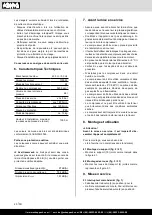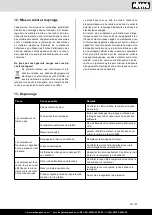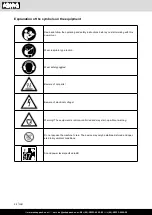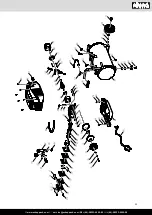
www.scheppach.com /
+(49)-08223-4002-99 /
+(49)-08223-4002-58
GB | 31
Please provide the following information in the event
of any enquiries:
• Type of current for the motor
• Machine data - type plate
• Machine data - type plate
11. Cleaning, maintenance, storage
and ordering spare parts
m
Important!
Pull out the power plug before doing any cleaning
and maintenance work on the equipment. Risk of
injury from electric shock!
m
Important!
Wait until the equipment has cooled down complete-
ly! Risk of burns!
m
Important!
Always depressurize the equipment before carrying
out any cleaning and maintenance work! Risk of in-
jury!
11.1 Cleaning
• Keep protective devices, air vents and the motor
housing as free of dust and dirt as possible.
• We recommend that you clean the device directly
after every use.
•
Rub the device clean with a clean cloth or blow it off
with compressed air at low pressure.
• Clean the device at regular intervals using a damp
cloth and a little soft soap. Do not use any cleaning
products or solvents; they could attack the plastic
parts of the device. Make sure that no water can
penetrate the device interior.
• The hose and injection tools must be disconnected
from the compressor before cleaning. The com-
pressor must not be cleaned with water, solvents
or similar.
11.2 Maintenance work on the pressure vessel
(fig. 4)
m
Important! To ensure a long service life of the
pressure vessel (7), drain off the condensed wa
-
ter by opening the drain valve (11) each time af-
ter using.
Release the vessel pressure at the overpressure
valve (2) beforehand. Open the drain screw by turn-
ing counter-clockwise (looking at the screw from the
bottom of the compressor) so that all the condensed
water can run out of the pressure vessel. Then close
the drain screw again (turn it clockwise). Check the
pressure vessel for signs of rust and damage each
time before using. Do not use the compressor with
a damaged or rusty pressure vessel. If you discover
any damage, then please contact the customer ser-
vice workshop.
m
Important!
The condensed water from the pressure vessel will
contain residual oil. Dispose of the condensed water
in an environmentally compatible manner at a suit-
able collection point.
11.3 Safety valve (Fig. 1)
The safety valve (5) has been set for the highest per-
mitted pressure of the pressure vessel. It is not permit-
ted to adjust the safety valve or remove the connec-
tion lock (5.2) between the exhaust nut (5.1) and its
cap (5.3).
Actuate the safety valve every 30 operating hours but
at least 3 times a year, to ensure that it works when
required. Turn the perforated exhaust nut (5.1) coun-
terclockwise to open it and use your hands to pull the
valve rod outwards over the perforated exhaust nut
(5.1) to open the safety valve outlet. Now, the valve
audibly releases air. Then, tighten the exhaust nut
clockwise again.
11.4 Storage
Store the device and its accessories in a dark, dry
and frost-free place that is inaccessible to children.
The optimum storage temperature lies between 5 and
30 ˚C.
m
Important!
Pull out the mains plug and ventilate the equip-
ment and all connected pneumatic tools. Switch
off the compressor and make sure that it is se
-
cured in such a way that it cannot be started up
again by any unauthorized person.
m
Important!
Store the compressor only in a dry location
which is not accessible to unauthorized per-
sons. Always store upright, never tilted!
11.5 Transport
• Use the transport handle (1) to transport the device,
and drive the compressor with it.
• When lifting the compressor, note its weight (see
technical data).
• Ensure that the load is well secured when trans-
porting the compressor in a motor vehicle.
11.6 Ordering spare parts
Please provide the following information when order-
ing replacement parts:
• Device type
• Device article number
• Device ID number
• Replacement part number of the required replace-
ment part






































